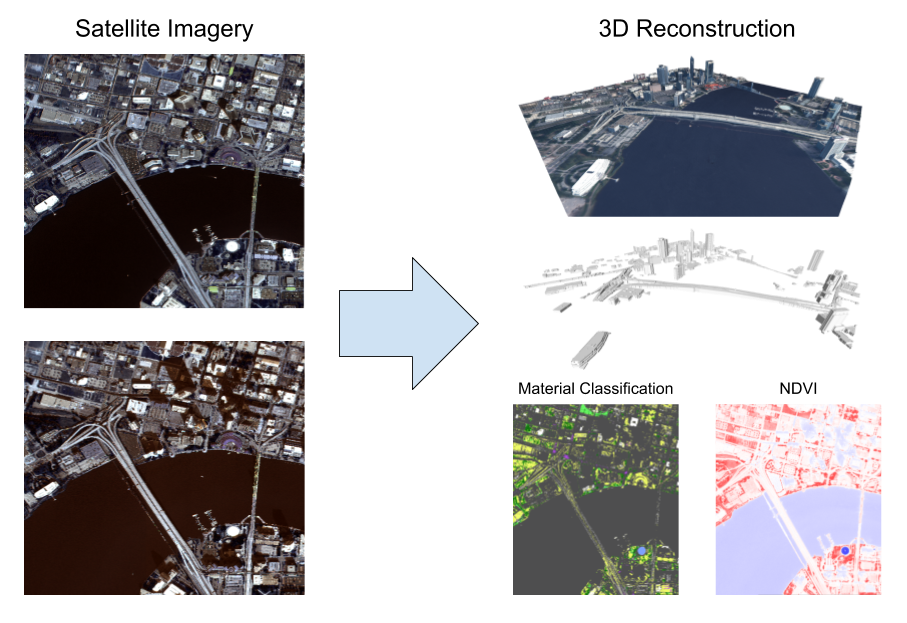This repository addresses the algorithmic challenges of the IARPA CORE3D program. The goal of this software is to reconstruct semantically meaningful 3D models of buildings and other man-made structures from satellite imagery.
This software is designed to process multiple view satellite imagery and is currently configured to process collections of panchromatic and multispectral WorldView3 imagery such as the examples provided in the public CORE3D Dataset. The algorithms were described in a Best Paper awarding winning paper at EarthVision 2019:
M. Leotta, C. Long, B. Jacquet, M. Zins, D. Lipsa, J. Shan, B. Xu, Z. Li, X. Zhang, S. Chang, M. Purri, J. Xue, and K. Dana, "Urban Semantic 3D Reconstruction From Multiview Satellite Imagery," in The IEEE Conference on Computer Vision and Pattern Recognition (CVPR) Workshops: EarthVision, 2019.
The Danesfield project has evolved since this publication. For details, see Project History.
This repository contains the algorithms to solve the CORE3D problem, but a web-based user interface and cloud-based processing infrastructure are provided in a separate project called Danesfield-App. The algorithms in this repository are written in Python or provide a Python interface.
Clone this repository with its sub-modules by running:
git clone --recursive git@github.com:Kitware/Danesfield.git
To fetch the latest version of this repository and its sub-modules, run:
git pull git submodule update --init --recursive
The first step in running or developing Danesfield code is to obtain the correct development environment. The Danesfield algorithms require a number of dependencies on geospatial and computer vision libraries. Provided with this repository are instructions for configuring a development environment with Conda. Conda provides a consistent development environment with a known configuration of dependencies versions. Follow the directions in deployment/conda/README.rst to setup this environment.
This repository has also been built into a Docker image, which
includes the required conda environment. The image is available from
Docker Hub at https://hub.docker.com/r/kitware/danesfield and can
be pulled down by running docker pull kitware/danesfield. The
image was built using the Dockerfile included in this repository.
As some of the Danesfield algorithms require a GPU, you'll need to
have NVIDIA Docker
installed, and use the nvidia-docker command when running the
image.
The Danesfield project is organized as follows:
- danesfield: directory where the Danesfield algorithmic modules live.
- tools: directory with command line tools to execute the Danesfield algorithms.
The Danesfield pipeline can be run from a command line using tools/run_danesfield.py and constructing a danesfield configuration file based on the example in input.ini.
If running via the docker container, first ensure you have the latest
danesfield docker image and nvidia-docker. Use nvidia-docker
to start a bash session inside the container:
nvidia-docker run -it --rm --gpus all --shm-size 8G\ -v /$DATA:/mnt kitware/danesfield /bin/bash
where $DATA is a path on the host to data directory containing your input
imagery or point cloud and input.ini. This host directory is mounted inside
the container at /mnt in the above command.
Once the environment is set up, you can execute a pipeline to process either multiple satellite images or start with a geospatial point cloud. To execute a pipeline with a point cloud, run
docker run --rm --gpus all -it -v ~/projects/danesfield:/root/danesfield core3d/danesfield 'LOGLEVEL=DEBUG python /danesfield/tools/run_danesfield.py /root/danesfield/run_danesfield/wrk/input.ini' > output_pointcloud.txt 2>&1
Note: input.ini should contain a valid point cloud path via p3d_fpath.
To execute a pipeline with a set of satellite images, run
docker run --rm --gpus all -it -v ~/projects/danesfield:/root/danesfield core3d/danesfield 'LOGLEVEL=DEBUG python /root/danesfield/danesfield/tools/run_danesfield.py --image /root/danesfield/run_danesfield/imageful/imageful.ini' >> output_image.txt 2>&1
Note: input.ini should contain a valid path to imagery via imagery_dir.
See comments in input.ini for each configuration option. To see more options on runnning danesfield pipeline, execute
python run_danesfield.py -h
where notable options are
--image: run pipeline with image data as the source; default uses a point cloud--roads: get roads from open street maps; default extracts no roads--vissat: run VisSat stereo pipeline using satellite imagery--run_metrics: run evaluation metrics; requires ground truth for DSM, DTM, etc.
Danesfield runs a variety of processing steps, some of which take advantage of multiple CPU cores and GPUs to accelerate processing large data sets. At a minimum Danesfield requires:
- 12GB RAM, 16GB preferred
- a modern CPU preferably multi-core
- a modern Nvidia GPU with 8GB of GPU RAM, 16GB preferred
The Danesfield project is named for Danesfield House in Buckinghamshire, England. This location was the center of Allied image intelligence during World War II. During the war, analysts use multiple overhead images to physically build 3D models of important sites.
Initial work on this project was funded by the IARPA CORE3D program in 2017 and 2018. The results of this initial work were presented at EarthVision 2019. At the time of this publication, Danesfield included a dependency on proprietary software developed by Raytheon. The Raytheon P3D software was used to extract point clouds from satellite images and bundle adjust RPC camera models. This dependency limited the use Danesfield to users with a license for the Raytheon P3D.
Since the initial CORE3D work, we have extended Danesfield in a few ways. First, we have since integrated VisSat as an open source alternative to P3D to allow for an end-to-end open source pipeline. Note that while VisSat works as a replacement to P3D, several downstream algorithms were trained on, or had parameters tuned for, P3D data. So results produced with VisSat instead of P3D may not achieve the same results as published.
Second, we have started to explore other input data in addition to WorldView 3. We have generalized the pipeline to allow processing a geospatial point cloud directly. This allows Danesfield to run on Lidar or other sources of point clouds. We are also exploring other options, such as integrating the TeleSculptor project to extract the point cloud from aerial video sources.
Third, we are adding open source tools to convert the meshes produced by Danesfield into the 3D Tiles format for more efficient transmission over the web.
